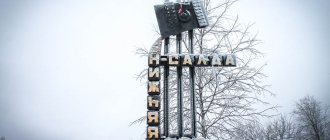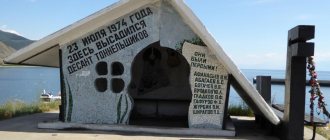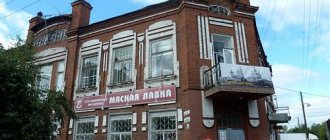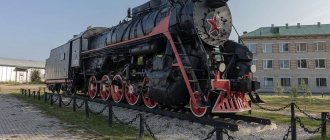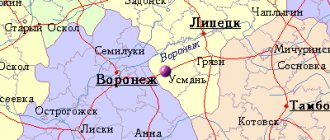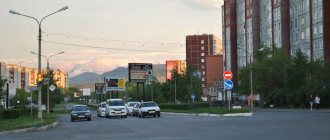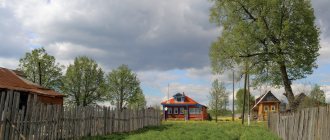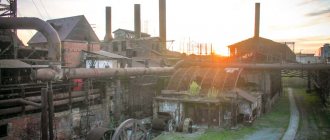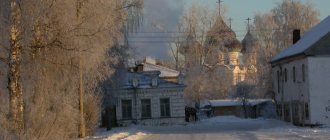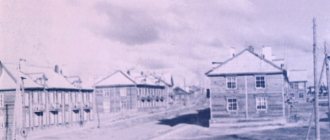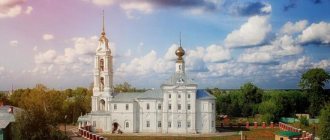Verkhnyaya Salda - a small town in Sverdlovsk region, where the world's largest plant producing products from titanium and its alloys is located. It appeared, like most other Ural cities, thanks to the dynasty Demidovswho opened a factory here. However, people settled the local lands long before the arrival of the Central Urals industrialists.
Photo by: Andrey Kopyrin
The city was founded on both sides of the Salda River , after which it was named. But the river got its name from the Mansi words “salt” (linden) and “da” (river), which can be interpreted as “linden river” or “river among lindens.” It is interesting that the northeastern border of the distribution of linden passes through the Saldinian land. However, some believe that the name of the city can be translated as “gold” - the precious metal was actually mined in the area before.
History of Verkhnaya Salda
The first cast iron at the Verkhnesalda plant was smelted on December 6, 1778. This day is considered the official date of birth of Verkhnaya Salda. The Verkhnesaldinsky plant was located in the Verkhoturye district of the Perm province, in the Nizhny Tagil mining district. It arose on the Salda River, the right tributary of Tagil.
The name of the river, according to linguist A.K. Matveev, comes from the Mansi word “salt”, “salt” - “bast”, “bast”. The northeastern border of the linden distribution runs precisely through these places.
Local historian N.K. Chupin in the “Geographical and Statistical Dictionary of the Perm Province” (1873) described this enterprise as follows:
“The production of the plant consists of smelting cast iron and preparing puddling pigs, both for our own use and for the Nizhne-Saldinsky plant, and partly in the production of high-quality iron. Ore - magnetic iron ore is brought from the Vysokogorsky mine, located 1 ½ versts from Nizhne Tagil... In terms of productivity, cast iron occupies one of the first places in all of Russia: in 1870 more than 657 thousand poods were smelted there, in 1871 - more than 800 thousand, and in 1873 already more than a million pounds of cast iron (none of the other iron smelters delivered such an amount in 1873).”
Before the construction of the railway, metal was sent to the central part of the country by water along the Chusovaya River.
In 1836, an Orthodox wooden church in the name of John the Evangelist was built at the Verkhnesalda plant. In 1896 it was replaced by a stone church.
In 1895, the Nizhny Tagil – Verkhnyaya Salda railway was launched. After the revolution, the plant was nationalized. In 1930, construction of another enterprise began in Verkhnaya Salda - a steel bridge plant.
On December 4, 1938, by Decree of the Presidium of the Supreme Soviet of the USSR, the workers' village of Verkhnyaya Salda was transformed into a city. In 1942 it became a city of regional subordination.
With the beginning of the Great Patriotic War, factories No. 95 and No. 519, which were engaged in the production of aluminum products for combat aircraft, were evacuated to Verkhnaya Salda.
In the 1950s, a new stage in the history of Verkhnyaya Salda began, it began to develop rapidly. Here they mastered the production of titanium for military equipment. Trial production began at plant No. 519, then an experimental workshop for the production of titanium products was opened at plant No. 95. The first experimental titanium ingot of the VT1-1 alloy weighed 4 kg and had a diameter of 100 mm. Titanium for rolling was supplied from the Podolsk Chemical and Metallurgical Plant. In 1957, plants No. 95 and 519 were merged. On January 24, 1976, for the first time in the world, the plant smelted an ingot with a diameter of 1200 mm and a mass of 15 tons.
In the 1990s, the company began cooperation with foreign companies. Later, the plant began supplying titanium parts for Boeing, and the company became deeply integrated into the global aerospace industry.
Today, the VSMPO-AVISMA Corporation is the world's largest enterprise producing products from titanium and its alloys. This is the only company that carries out a full cycle of titanium production - from processing raw materials to producing final products. The Corporation includes two industrial sites - VSMPO in Verkhnaya Salda and AVISMA in the city of Berezniki, Perm Territory, which are connected by a single technological chain.
Verkhnesalda titanium can be seen in Moscow. One of the most impressive monuments in the Russian capital, the “Conquerors of Space” monument on Mira Avenue, is made of polished titanium. It was opened on November 4, 1964. Depicts a rocket taking off, followed by a silver trail. The height of the monument reaches 100 meters, weight – 250 tons. The surface is covered with titanium panels 1.5 mm thick, the total weight of which is 25 tons.
In the 2010s, a special economic zone of the industrial-production type “Titanium Valley” appeared in Verkhnyaya Salda, in the creation of which a lot of money was invested. The territory of the “Titanium Valley” is located to the left of the road before entering the city.
The enterprise that gave life to the city was much less fortunate. The Verkhnesaldinsky Metallurgical Plant was declared bankrupt in 2015 and ceased to exist. By now, almost all the buildings on the territory of one of the oldest factories in the Urals have been demolished, now there is just a vacant lot surrounded by a fence.
Interestingly, in the 1960s, a master plan was developed to unite the cities of Verkhnyaya and Nizhnyaya Salda. It just so happened historically that from the very foundation they were connected with each other. The development of cities had to move towards each other. The population of Verkhnyaya Salda today is 42 thousand people.
Sights of Verkhnyaya Salda
The historical center of Verkhnyaya Salda is located near the former Verkhnyaya Salda metallurgical plant (now demolished). You can begin your acquaintance with the city from the St. John the Theological Church standing on the square. You can easily park next to it, and there is also a bus station nearby.
The stone three-altar Church of St. John the Theologian was founded in 1890 and consecrated in 1896. Built in neo-Byzantine style at the expense of parishioners. In 1930, the temple was closed for worship, and in the fall of 1936 it was blown up. In 1998, construction of a new temple began on the same site, externally reproducing the old one. It was consecrated in 2013 and is currently operating. Built of red brick, it has three thrones and a bell tower 43 meters high.
In the historical center of Verkhnaya Salda, many old buildings have been preserved. A restored two-story merchant house can be seen on Kalinin Street (house no. 36) leading to the temple. It was built in 1860, as indicated by the numbers under the roof. Before the revolution, there was a consumer society house and a store here, later a bakery and private enterprises. Now it houses a grocery store.
Returning to the square, pay attention to the bus station building (Lenin St., 54). This is a former priest's house . Outwardly, it looks unprepossessing, but a large memorial plaque catches the eye. The inscription on it says that from 1902 to 1918 the priest Peter Dyakonov, who was killed by the Bolsheviks in 1918, lived here. The Russian Orthodox Church ranked him among the holy martyrs. There was an underground passage from this house to the church. Other buildings were also connected by underground passages, but read about that below.
Turning right behind the bus station building, you should walk further along Lenin Street. On the left is the territory of the former Verkhnesaldinsky plant. Near the former checkpoint there is a monument to plant workers who died on the fronts of the Great Patriotic War. The inscription on the monument cries out: “People. While hearts are knocking, remember! At what price is happiness won? Remember!
On the right side there is a complex of old pre-revolutionary buildings. One-story green house on the street. Lenina, 62 – former factory hospital . In Soviet times, various institutions were located here, until the mid-90s the house was occupied by the VSMZ trade union committee, then the building was empty, now, apparently, commercial companies are located.
The next building looks the most expressive. This is the building of the management office of the Verkhnesaldinsky plant (Lenin St., 64), built in 1858 by order of the owners of the Tagil factories in the style of Russian classicism according to the design of the architect A.P. Chebotareva. The central part of the facade is decorated with four columns. Above them you can see the Demidovs’ coat of arms and floral ornaments. After the revolution of 1917, the house housed the VSMZ plant management, since the 1960s - the city House of Pioneers, in the 1990s - the Center for Children's Creativity, and since 1996 - the Verkhnesalda Museum of Local Lore. The building is an architectural monument.
The last one is the former house of the manager of the Verkhnesaldinsky plant (Lenin St., 66). It was built in 1831 (according to other sources, in the 1850s). In the second half of the 19th century, Maria Yakimovna Alekseeva, the first wife of the writer D.N., lived in this house for some time. Mamin-Sibiryak. In 1897-1901, the family of the outstanding metallurgist Vladimir Efimovich Grum-Grzhimailo lived here after his appointment as manager of the Verkhnesalda plant, as a memorial plaque reminds. Grum-Grzhimailo’s wife, Sofya Germanovna, left memories of the house and life in it. After Grum-Grzhimailo moved to neighboring Nizhnyaya Salda, the house was actually used as a hotel. After the revolution of 1917, the commissariat for the formation of Red Guard detachments, the surgical department of the city hospital, a kindergarten, and a city printing house were located here in different years (it is still located here). Nowadays, in the basement of the house, Yegor Korolev discovered a smelting furnace, apparently built by V.E. himself. Grum-Grzhimailo for metal smelting experiments.
Next begins the Verkhnesaldinsky pond on the Salda River, which is a decoration of the city. It has the status of a hydrological natural monument of the Sverdlovsk region. Just above the pond, the rather interesting Isa River flows into Salda, on which the Isinsky Pond is formed, which is also a natural monument.
Returning to the square, it is worth paying attention to the monument to the heroes of the Civil War . It was erected in memory of the Saldinians who died in this terrible war. The monument stands on the grave of the Red intelligence officer Mikhail Afanasyevich Turanov, who was killed by the White Guards in 1919. It was opened in 1955, made according to the design of the famous sculptor L.M. Pisarevsky.
On the right is a memorial stone to the victims of political repression . And behind these monuments stands the building of the Aleksandrovsky Primary Zemstvo School (Lenin St., 31). This two-story building was built in 1872. Since the 1990s, the city's education department has been based there.
Across the road is a two-story building of the former volost government (Lenin St., 50). In Soviet times, it was connected by an extension to the house of the clergyman Father Alexei. Until 1917, the volost administration and police district were located here, since 1917 - the Executive Committee of the Verkhnesalda volost Council of Workers' and Soldiers' Deputies, the city committee of the All-Union Communist Party of Bolsheviks, the city committee of the Komsomol, the city executive committee, the people's court, and the prosecutor's office. These days the building is abandoned and is gradually collapsing.
If you walk further along Lenin Street, you can see another example of the attitude towards pre-revolutionary buildings, which gives some hope. A local entrepreneur himself restored the house of the merchant Vershinin (Lenin St., 44). Before the revolution, there was a store on the ground floor, living rooms on the second, and storage rooms in the basement. In Soviet times, there was a store on the ground floor, and the city military registration and enlistment office on the second. Today the building was sold to a private person. Once in the hands of a responsible owner, the merchant's house regained its former splendor. Now it houses a cafe and a hotel. In the courtyard of the house there is a small open-air museum where you can see, for example, examples of antique rails.
The modern center of Verkhnaya Salda is located away from the historical one. The most interesting thing here is near the Palace of Culture. G.D. Agarkova (Engelsa St., 32). The building of the cultural center was built according to a standard design in 1956. Named after the former director of the plant. In front of the Palace of Culture lies the Palace Square with the “Danila the Master” fountain . The metal sculpture depicts the hero of the tale P.P. Bazhov holding a “stone flower” in his hands.
To the left of the Palace of Culture is the Cosmos Park. The monument “Girl with Swallows ”, standing on a high pedestal, deserves attention It is one of the unofficial symbols of Verkhnyaya Salda. The monument was made by Saldinsky sculptor L.E. Neverov. In the past, the monument stood on the road between Verkhnyaya and Nizhnyaya Salda. After an attempt was made to steal the bronze monument in the early 1990s, the monument was moved to the plant management building, and later moved to the Palace of Culture named after. Agarkov, to the Cosmos park. Across the road there is a park of culture and recreation named after. Yu.A. Gagarin.
Also within the city limits of Verkhnyaya Salda there is Mount Melnichnaya, on which the ski base of the same name is located. And lovers of abandoned buildings are attracted by the large building of an unfinished hospital. A huge hospital complex was built for two cities - Verkhnyaya and Nizhnyaya Salda, but with the collapse of the Soviet Union this construction was abandoned.
To the east of the city there is a botanical natural monument “Lomovsky Garden” - a monument to human forestry activities. The garden was planted in 1910-12. Initially, 4 alleys of cedars and pines were planted along the perimeter, later - birch, bird cherry, apple, acacia, and lilac. The Lomovka holiday home, opened in 1935, operates here.
Honorary citizens
- Agarkov, Gavriil Dmitrievich (1905-1992) - Soviet engineer and major economic manager, candidate of technical sciences (1969). Honorary citizen of the city of Verkhnyaya Salda (1975).
- Grum-Grzhimailo, Vladimir Efimovich (1864-1928) - scientist, metallurgical engineer.
- Demchenko, Vasily Mikhailovich (1906-1983) - doctor, surgeon, chief physician of the Nizhnesaldinsk City Hospital, head of the surgical department.
- Efremova, Maria Petrovna (1920-2006) - teacher, primary school teacher. The title “Honorary Citizen of the City of Verkhnyaya Salda” was awarded in 1990.
- Kalinina, Antonina Petrovna (1926-2003) - builder. The title “Honorary Citizen of the City of Verkhnyaya Salda” was awarded in 1975.
- Koshcheev, Boris Mikhailovich (b. 1930) - infectious disease doctor, head of the infectious diseases department of the central city hospital. The title “Honorary Citizen of the City of Verkhnyaya Salda” was awarded in 1998.
- Neverov, Leonid Efimovich (b. 1931) - sculptor, author of monumental compositions in cities of Russia and neighboring countries. The title “Honorary Citizen of the City of Verkhnyaya Salda” was awarded in 1995.
- Salosyatov, Andrei Timofeevich (1907-1981) - party, Soviet worker. Chairman of the Verkhnesalda City Council. The title “Honorary Citizen of the City of Verkhnyaya Salda” was awarded in 1975.
- Stremousov, Viktor Alekseevich (b. 1927) - candidate master of sports in skiing, repeated champion of the Sverdlovsk region in skiing and pentathlon. The title “Honorary Citizen of the City of Verkhnyaya Salda” was awarded in 2008.
- Tetyukhin, Vladislav Valentinovich (b. 1932) - scientist, manager of titanium production. Doctor of Technical Sciences. Academician of the Russian Academy of Engineering Sciences. Headed VSMPO-AVISMA Corporation OJSC. The title “Honorary Citizen of the City of Verkhnyaya Salda” was awarded in 1997.
- Khodanetskaya, Taisya Aleksandrovna (b. 1929) - teacher, awarded the badge “Excellence in Public Education of the RSFSR”, “Honored School Teacher of the RSFSR”. The title “Honorary Citizen of the City of Verkhnyaya Salda” was awarded in 2010.
- Zorikhina, Yulia Sergeevna (b. 1952) - teacher, public figure. The title “Honorary Citizen of the City of Verkhnyaya Salda” was awarded in 2013.
- Cherkasov Vladimir Viktorovich (b.1947) - teacher, title “Honored Worker of Culture of the RSFSR”, 1986. Badge of the USSR Ministry of Culture “For excellent work”, 1982.
- Shatalov, Alexander Nikolaevich (b. 1948) - director of the Verkhnesalda Multidisciplinary College named after. A. A. Evstigneeva since 1989, public figure. The title “Honorary Citizen of the City of Verkhnyaya Salda” was awarded in 2013.
- Krasheninina, Lyudmila Petrovna (b. 1944) - director of the autonomous educational institution of additional education for children "Renaissance Children's Art School". Honored Worker of Culture of the Russian Federation. The title “Honorary Citizen of the City of Verkhnyaya Salda” was awarded in 2014.
Dungeons of Verkhnaya Salda
One of the main secrets of Verkhnyaya Salda is connected with underground passages. They are described in detail in Vsevolod Slukin’s book “Secrets of the Ural Dungeons”.
Verkhnesalda local historian Viktor Ivanovich Kozlov reported to V.M. Slukin that “under Verkhnaya Salda, according to the tales of old-timers, according to his personal observations and some other evidence, there is a whole system of galleries and corridors. This system is laid under the historical center in the old part of the city. The passages connect the old plant, the building of the former parish school (there was once the first church, from Demidov's times), the house of the plant manager, the building of the volost government, and the priests' mansions. There seems to be a branch to another part of the city, passing under the river to where Salda School No. 6 is located.”
Diagram of the underground passages of Verkhnyaya Salda from the book by V.M. Slukin “Secrets of the Ural dungeons”
There were many eyewitnesses who saw the mysterious dungeons. For example, they came across brickwork during the construction of a garage in the courtyard of the former mansion of Father Mikhail (now it houses a bus station). The builders widened the resulting gap and fell into an underground passage.
“The tunnel was lined with large-sized Demidov bricks, the vault was also brick, cylindrical, massive. The floor is covered with granite slabs. The dimensions of the corridor are typical for structures of this type: one and a half meters wide, about two meters high.
But the most important thing awaited the pathfinders ahead - after a few meters the passage branched into three branches. One went to the left, towards the Cathedral of St. John the Evangelist, which once stood on a hill (demolished during the years of churchlessness), the second went straight, towards the building of the volost government and the house of the second clergyman - Father Alexei, and the third branched to the right - to the building that once existing parochial school. We chose the path straight, but soon it was blocked by a brick wall of relatively recent masonry, dating back to approximately the beginning of the 20th century,” Vsevolod Slukin described the find from the words of an eyewitness.
Similar brickwork was found during excavation work and near the former estate of the plant manager. There were also periodic sinkholes there.
In the past, it was possible to get into the underground tunnel from the school building, which was located in the parish building. Based on the story by A.F. Onosov, he and his classmates walked through the tunnel for more than a hundred meters. Unfortunately, the building later burned down. In May 1979, V.I. Kozlov and a group of enthusiasts examined the basement of the burnt building. A room measuring 5 by 6 meters, the height of a person, was discovered. In the opposite wall there was a narrow passage half a meter wide. It was a secret passage to the basement. On the left side of the basement, a large room opened up with smooth walls and forged nails driven in at the level of hanging icons and lamps. A blind bunker measuring 3 by 4 meters was discovered under the floor. On the left there was another similar bunker, and in the center there was a hole into an underground passage, but the further path was blocked by ice.
Director of Verkhnesaldinsk school No. 9 N.V. Sorokin told researchers that he walked along an underground passage from the school building (it was also old) to the parish school and further to the side where the main Cathedral of St. John the Evangelist once stood. During the investigation, a machine gun from the Civil War was found.
According to the stories of Verkhnyaya Salda residents, another passage went from the old building on the other side of the river, which in the past was occupied by school No. 6 (before the revolution it was part of the ensemble of factory administrative buildings), to the old center of Verkhnyaya Salda.
In 1982, exploration was carried out using engineering geophysical methods. Instruments confirmed the presence of voids...
In November 2022, we, participants in the “Uraloved” project, also visited Verkhnyaya Salda. Since the time of writing by V.M. Slukin’s books about dungeons, not much has changed here. Except that a new one was built on the site of the demolished temple. It is a pity that the builders did not try to find and explore the underground passages.
After walking through the historical center of the city and looking at the buildings that were connected by underground passages, we headed to the former building of the volost government.
The building turned out to be abandoned, and we had the opportunity to visit inside. Alas, the pre-revolutionary building is in disrepair and is gradually collapsing. The floor in one of the rooms was broken. An ancient arched vault made of old brick was visible there. Did it really lead to those same legendary underground passages of Verkhnyaya Salda?!
We go down and look under the arches, which beckon with their mystery. The mysterious emptiness went into the distance... Having made our way along, alas, further there was a dead end. Everything is covered with a huge mass of slag...
How great it would be to excavate and restore ancient underground passages! An influx of curious tourists in Verkhnaya Salda would be guaranteed. In the meantime, the underground passages of Verkhnyaya Salda continue to keep their secrets...
How to get to Verkhnyaya Salda?
The city of Verkhnyaya Salda is located in the Sverdlovsk region, 43 km northeast of Nizhny Tagil or 170 km north of Yekaterinburg. From Yekaterinburg you need to go along the Serovsky tract and stop in Nizhny Tagil. The Sverdlovskoye Highway smoothly turns into Festivalnaya Street, along which you need to drive to the end, then turn right onto the Eastern Highway, which turns into the highway to Verkhnyaya Salda.
You can also get there by public transport. Buses from Yekaterinburg and Nizhny Tagil, as well as trains from Tagil and Alapaevsk go here.
10 km from Verkhnyaya Salda is the city of Nizhnyaya Salda, which is definitely also worth a visit.
Pavel Raspopov
Literature used: Verkhnyaya Salda - Wikipedia Korolev Egor. The monument to the “Conquerors of Space” was created from Salda titanium Egor Korolev. Salda “underground floors” Korolev Egor. Treasures of the old citySalda History websiteSlukin V.M. Secrets of the Ural dungeons. – Ekaterinburg, 2005.
See also:
- Old photos of Verkhnyaya and Nizhnyaya Salda
- Nizhnyaya Salda city
- Pages from life in the Urals (early 20th century). Memoirs of Margarita Durdenevskaya. Chapter I. Verkhnaya Salda
Famous townspeople
- Sigarev, Vasily Vladimirovich (b. 1977) - playwright, screenwriter, film director.
- Arefieva, Olga Viktorovna (b. 1966) - singer, musician, poet, creator and leader of the group “Ark”. Member of the Russian Writers' Union.
- Bykov, Vladislav Vladimirovich (b. 1954) - writer, player of intellectual games.
- Kuznetsov, Vladimir Aleksandrovich (1874-1960) - artist, Honored Artist of the RSFSR.
- Zhuravlev, Anatoly Anatolyevich (born 1964) - Russian theater and film actor.
- Pryanichnikov, Ivan Aleksandrovich (1918-1967) - poet.
- Puzey, Nikolai Mikhailovich (1915-2000) - composer. Honored Artist of the RSFSR (1977). Member of the Union of Composers of the Sverdlovsk Region (1977-1988 - chairman). Professor of the Ural State Conservatory named after M. P. Mussorgsky (1970-1992 - head of the department of composition and instrumentation).
